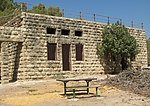Neve Shalom
1969 establishments in IsraelHarv and Sfn no-target errorsIntentional communities in IsraelIsraeli–Palestinian peace processMateh Yehuda Regional Council ... and 6 more
Mixed Israeli communitiesNon-governmental organizations involved in the Israeli–Palestinian peace processNon-profit organizations based in IsraelPeace organizations based in IsraelPopulated places established in 1969Populated places in Jerusalem District

Neve Shalom (Hebrew: נְוֵה שָׁלוֹם, lit. 'Oasis of Peace'), also known as Wāħat as-Salām (Arabic: واحة السلام) is a cooperative village in Israel, jointly founded by Israeli Jews and Arabs in an attempt to show that the two peoples can live side by side peacefully, as well as to conduct educational work for peace, equality and understanding between the two peoples. The village is located on one of the two Latrun hilltops overlooking the Ayalon Valley, and lies midway between Tel Aviv and Jerusalem. Falling under the jurisdiction of Mateh Yehuda Regional Council, in 2021 it had a population of 356.
Excerpt from the Wikipedia article Neve Shalom (License: CC BY-SA 3.0, Authors, Images).Neve Shalom
Mate Yehuda Regional Council
Geographical coordinates (GPS) Address Nearby Places Show on map
Geographical coordinates (GPS)
| Latitude | Longitude |
|---|---|
| N 31.817777777778 ° | E 34.979722222222 ° |
Address
Mate Yehuda Regional Council
Jerusalem District, Israel
Open on Google Maps











